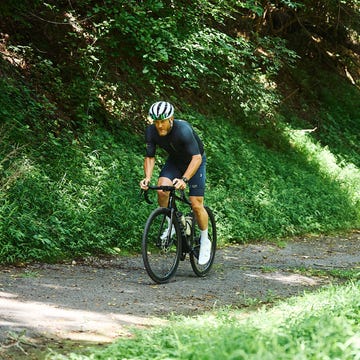The Takeaway: Transition’s third-generation Sentinel changes are nothing radical or eye-catching. Instead, they prove that great mountain bikes don’t need proprietary features, weird standards, or technologies (which will surely provide additional headaches in the future). This mid-travel trail bike is easy to own and live with and offers excellent all-around performance. It’s also a better value than many bikes, which makes it especially compelling.
From a distance, Transition’s new, third-generation Sentinel looks similar to the second-generation bike it replaces. While the suspension travel remains the same (150mm rear/160mm front), Transition adjusted the bike’s mission and feel to make it a more versatile and livelier trail bike.
In a wide-ranging phone conversation, Lars Sternberg, Transition’s product specialist, explained the Sentinel’s new attitude by detailing the history of the brand’s long-travel 29er offerings. The Sentinel was once Transition’s longest-travel 29-by-29-wheel bike. But with that role now delegated to the Spire (170mm front and rear), Sternberg stated that going into the third-generation update, Transition took time to “reassess what the Sentinel is.”
Transition made adjustments and updates to the third-generation Sentinel to shape it into a bike that the brand labels as the sweet spot—It’s the one mountain bike to own when you like to ride everywhere and everything. Though small, the changes edge the Sentinel from its previous life as a gravity-oriented bike by taking inspiration from Transition’s shorter travel bikes, like the Spur (120mm front and rear) and the Smuggler (130mm rear, 140mm front).
What’s New
While the gen.3 Sentinel isn’t radically different from the gen.2, Transition still made numerous tweaks to most areas of the bike. The most significant is adding in-frame storage, a first for Transition. However, the company does it differently than most because it does not pair the bottle cage mount with the access door.
Instead, the Sentinel has an ordinary bottle cage mount in the middle of the downtube, with storage access located lower on the downtube. Sternberg explained that they settled on this approach after testing and evaluating the different options. It proved quieter and offered better door sealing.
The Sentinel ships with two bags for in-frame storage. One is specifically sized for a OneUp 70cc EDC pump, while the other has multiple zippered compartments for organizing items. Under the downtube, the Sentinel also has a mount for a cargo plate or other accessory.
I found Transition's in-frame storage better executed than most. It has a decent amount of room, and the hole is generously sized, so the bags come out with little fuss.
However, I once pushed one of the bags inadvertently high in the downtube, and it became stuck and out of reach. Thankfully, I was in my shop and could free it by hooking it with a bent wire. The story’s moral is: Don’t carelessly shove stuff into the frame. (But it would be helpful if Transition placed a bulkhead in the downtube to stop bags from traveling too far.)
Transition ships the Sentinel with a Fidlock twist base pre-installed. My medium bike easily fits Fidlock’s 750ml bottle, with generous clearance under the top tube and at the shock reservoir. (I did not have an opportunity to check clearances with Fidlock’s 800ml bottle.)
For comparison, I checked clearance with a standard bottle cage and bottle. While there is room for a Specialized 710ml Big Mouth, a 750ml Purist bottle did not clear the top tube. So, although Fidlock’s bottles are silly-expensive, the system (especially on smaller Sentinel frames) offers a capacity advantage.
As expected for a model update, the Sentinel’s suspension also received attention.
Like the previous generation, Transition approves the Sentinel V3 with a different shock stroke length for riders who want to tweak the bike’s character. The difference is that while the V2 was designed to accommodate a shorter stroke shock, which bumped rear travel down to 140mm, the v3 is approved for a longer stroke shock, which bumps rear travel up to 160mm.
The team at Transition also tinkered with the kinematics, slightly increasing progression to 24 percent (the Sentinel is coil-shock approved) and adding more support early in the travel. It says this makes more travel available for bigger hits and gives the bike a livelier feel.
Hose and housing routing also received some love. Transition adopted a modular chip system on both the left and right side of the downtube that supports right/rear and right/front (“moto”) braking setups with mechanical shifting and cable-actuated dropper posts.
Transition deviates from the norm because it doesn’t offer fully guided routing inside the frame. Instead, hoses and housing are free inside the downtube and intended to be foam-wrapped and secured against the sides of the downtube by zip-tie anchors around the rim of the cargo access hole. Sternberg told me Transition took this approach because it accommodates more options (particularly moto brake setups) more easily.
Although it ships as a matched 29-inch wheel bike, the new Sentinel is approved for use with a 27.5-inch rear wheel. With the smaller rear wheel, the company suggests running the flip chip in the lower shock mount in the “high” position.
Last on the list are updates and changes to the bike’s geometry. In short, the Sentinel now has size-specific seatstays, a new XS size (that rolls on 27.5-inch wheels), and some minor tweaks to angles and lengths.
Build Kits and Prices
The Sentinel arrives in two frame material choices—the aluminum frames do not get in-frame storage, and the geometry is slightly different—and three build kits.
Transition offers Shimano Deore and Shimano XT builds with either the carbon or aluminum frame. The Shimano groups are paired with RockShox forks and shocks, though there are slight differences in fork and shock details per frame material.
The third kit, only paired with the carbon frame, is an SRAM X0 AXS drivetrain with Fox suspension parts.
Complete bike prices start at $3,299 for the aluminum Sentinel with Shimano Deore and top out at $7,899 for a carbon frame with SRAM X0 AXS Transmission.
Geometry
Geometry changes from second to third generation are minimal, other than the new XS size with matched 27.5” wheels. However, note the table carefully because the geometry for the carbon and aluminum versions of the Sentinel has slight variations
The highlight update to the V3 is the adoption of size-specific chainstays. All sizes of the V2 Sentinel ran 440mm stays, while the V3 gets 434 to 448mm stays, depending on size.
However, perhaps the most surprising thing is that the carbon V3 is slightly shorter and taller than the V2. In the size medium I ride, the top tube gets a bit shorter—eight millimeters, largely due to a steeper seat angle—and the bottom bracket is about five millimeters higher.
As previously noted, the Sentinel is approved for use with a 27.5” rear wheel. With the smaller wheel fitted, Sternberg stated, “Reach shrinks by 4mm per size, BB height is lower by 6mm, head and seat are 0.4 degrees slacker, and the chainstays are 2mm shorter.”
Ride Impressions
True to its mission, the Sentinel handled a wide range of terrain and trail situations superbly during my testing. Because it is so consistent, I find it challenging to articulate the bike’s individual qualities.
Every ride on the Sentinel V3 is great; everywhere I took it, it felt at home. The bike climbs surprisingly well and is nigh-unflappable when I push it to my limits. Plus, the suspension is well-tuned and smooth and the handling is balanced and intuitive. Simply put; this bike works.
My only real complaint is the short cockpit for seated pedaling. This Sentinel’s top tube is two to three centimeters shorter than I prefer. That short top tube, combined with the steep seat angle (78.2 degrees effective at my 730mm saddle height) and short 165mm cranks, makes me feel scrunched when pedaling from the saddle, even with the saddle slammed back.
I could bump the stock 40mm stem up to a 50mm (I find modern trail bikes start to handle oddly with more than a 50mm stem), but that would start to mess with the Sentinel’s handling, which I loved and very much did not want to mess with. Though I found it less than ideal (and occasionally a bit uncomfortable on longer climbs), I dealt with the short seated position because the bike was so brilliant in all other ways.
Although the position is shorter than I prefer, the Sentinel’s climbing performance is an unexpected bright spot. And I say “unexpected” because my review bike weighs a stout 32.3 pounds (Bicycling weighs bikes without pedals, bottle cages, or other accessories). Even so, the Transition is a surprisingly deft climber with satisfying efficiency, good support, and plenty of traction. It has been a while since I’ve had a bike that rides lighter than the scale suggests, but that certainly describes this Sentinel.
The short feeling of the cockpit disappeared when I dropped the saddle and stood up. The bike’s reach is generous, placing the rider in a comfortably balanced riding position.
Perhaps that balance is partly due to the longer—than the typical trail bike in my size—442mm chainstays. Reason(s) aside, the Sentinel is a composed bike at speed and free of drama in the steeps but remains relatively spry when trails are slower and flatter.
This bike’s overall demeanor is decidedly on the quiet and composed end of the spectrum instead of leaning lively and jibby. I usually prefer a more reactive bike, but this Sentinel has me rethinking that preference. I felt so comfortably in command on this bike and I relished the relaxed confidence it gave me. It worked, too, because I rode challenging trails well on this bike and with far less sense of impending doom than usual.
After many hours on the Sentinel, I came away mightily impressed. It is low-key because it is free of bike-industry “signature” technologies and features and embraces common standards. But don’t let its ordinaryness fool you: This bike rips. Plus, Transition’s pricing seems better than many, offering solid builds at a fairer price than usual.
There are many good trail bikes available today. I’ve tested many of them, and the new Transtition Sentinal is one of the very best.
Notes From the Field
• I can’t say if all Sentinels are the same, but my test bike is, I think, the quietest mountain bike I’ve ever tested. Like, nearly silent. This is extra impressive because the bike I tested has mechanical shifting and a cable-actuated dropper instead of cable-and-housing-free wireless units. I love quiet bikes, and I always go to lengths to try to silence the bikes I ride, but I’ve never experienced anything like this Sentinel.
• While cleaning this bike after a muddy ride, I noticed that, while hosing it off, a bit of water got past the door’s seal and leaked into the downtube.
• The build on my Carbon XT review bike is great. In a nod to simplicity, durability, and lower replacement costs, the kit has no carbon (other than the frame) and no batteries. It functioned perfectly and was, as previously noted, quiet.
• Another note on the build: I loved seeing Maxxis EXO+ tire casings and a 200mm rear rotor as stock equipment (versus the typical standard casings and a 180mm rear rotor). On a bike like the Sentinel, riders usually end up buying the heavier-duty bits down the line. It’s nice that Transition didn’t try to save a few grams and put the good stuff on the bike from the beginning.
• With SRAM dominating the new mountain bike drivetrain space recently, it’s been a while since I’ve received a test bike with Shimano XT. This is a shame because the shifting is superb—I love the light and smooth snick-snick of Shimano’s paddles— and the brakes are also excellent. SRAM’s Transmission drivetrain is great, but I think Shimano’s mechanical groups shift more smoothly than SRAM’s mechanical groups. My bike’s brakes were even free of Shimano’s wandering bite point issue. Overall, the Shimano parts functioned flawlessly, had no batteries to monitor, and required no maintenance other than chain lube.
• I love that Transition includes shock setup information on the back of the bike’s seat tube. It’s easy to read and doesn’t require searching through manuals, web pages, or apps.

A gear editor for his entire career, Matt’s journey to becoming a leading cycling tech journalist started in 1995, and he’s been at it ever since; likely riding more cycling equipment than anyone on the planet along the way. Previous to his time with Bicycling, Matt worked in bike shops as a service manager, mechanic, and sales person. Based in Durango, Colorado, he enjoys riding and testing any and all kinds of bikes, so you’re just as likely to see him on a road bike dressed in Lycra at a Tuesday night worlds ride as you are to find him dressed in a full face helmet and pads riding a bike park on an enduro bike. He doesn’t race often, but he’s game for anything; having entered road races, criteriums, trials competitions, dual slalom, downhill races, enduros, stage races, short track, time trials, and gran fondos. Next up on his to-do list: a multi day bikepacking trip, and an e-bike race.


























